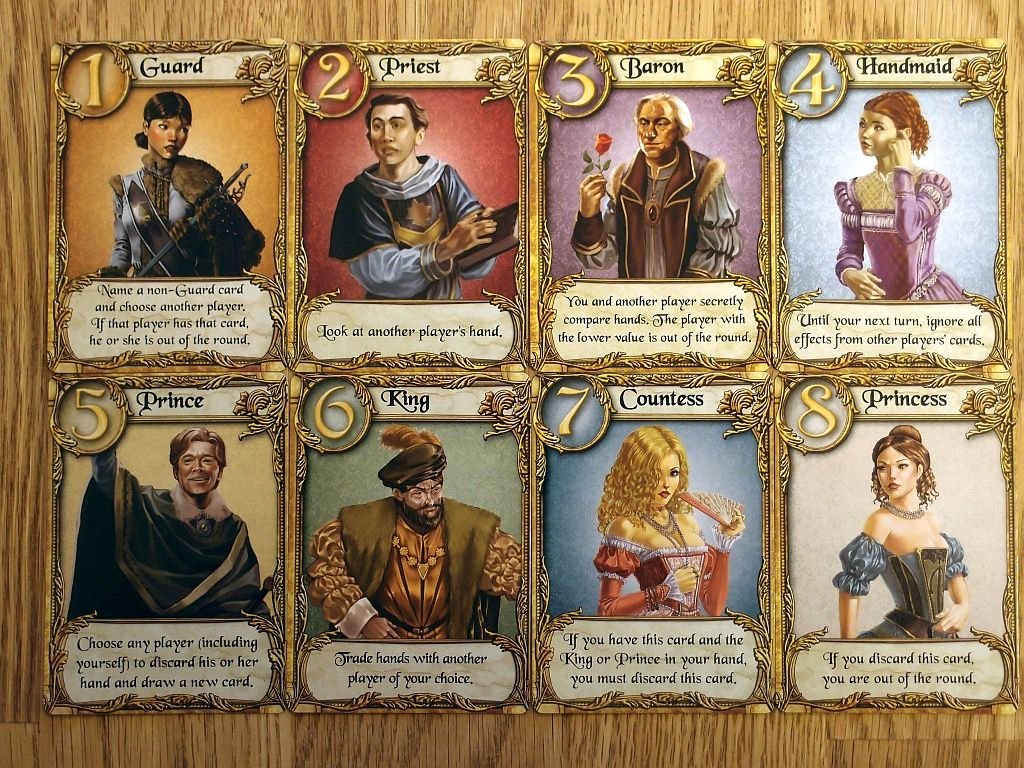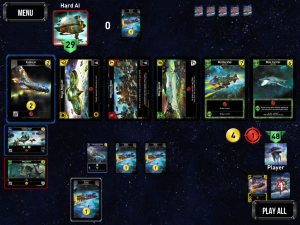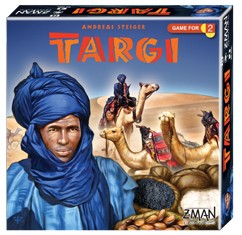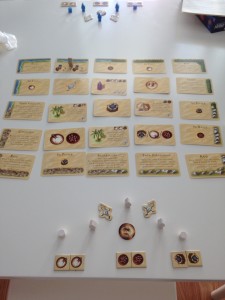Valeria: Card Kingdoms came out in 2015 from Daily Magic Games and has been steadily expanded ever since, including the latest release, this summer’s Flames & Frost, which is also the largest Valeria expansion to date. The game combines some great elements of other games, including the extensibility of Dominion, but more than anything else it takes the core mechanic of Machi Koro and improves on it dramatically. The theme is different, and there are other major variations, but this really is Better Machi Koro, to the point that I can’t imagine pulling MK out again now that we have Valeria on the shelves.
Valeria will at least start out as familiar to Machi Koro players: Each player starts with two cards, a Peasant (with the number 5 on it) and a Knight (number 6), and on every turn, the active player rolls the two dice to ‘activate’ certain cards. In Valeria, three cards are typically activated with each dice roll – the number on each individual die and the total of the two. (If they’re equal, some cards will thus be activated twice.) If you are the active player and you have any cards with those numbers on them, you get a specific reward in gold, magic, or strength tokens; if you’re not the active player, you also get a reward, but it’s usually smaller than what the active player gets.
On each turn, you get two actions, and can do one of four things. One is to just take a single gold, magic, or strength token, which is especially useful at the beginning of the game, but isn’t exactly why you’re here. The second action is to buy a Citizen card from the table. Citizens are numbered from 1 through 8, plus a 9/10 card and an 11/12 card. Citizens with higher-probability dice rolls on their cards cost more to buy, and, unlike in Machi Koro, you pay more to buy multiple copies of the same card – face value plus one more gold coin for each copy of the card you already have.
The third action is to buy a Domain card, which range from 5 coins to at least 12 coins, and give you end-game victory points as well as some recurring extra abilities or bonuses during the remainder of the game, such as reducing some card costs or allowing you to steal tokens from other players every turn. The fourth is to ‘defeat’ a Monster card on the table; there are five stacks of Monsters, sorted by type (a symbol in the upper left), and they get increasingly difficult to defeat as you move down the stack. You defeat Monsters with strength tokens and sometimes with magic tokens as well, earning an immediate reward (usually gold and/or other tokens, sometimes a free Citizen card instead) and end-game victory points.
There’s one other avenue to points that is unique to each player. At the start of the game, you’re dealt two Duke cards that detail specific game-end bonuses that are tied to the symbols found in the upper right of all cards (Domains, Monsters, and Citizens, especially the first two), or just to the number of Domains you bought or Monsters you defeated, and something for the leftover tokens you have. Add the points from your Duke to the points on your Domains and Monsters and any extra points you picked up during the game (some Citizens let you take a victory point rather than, say, two gold) and you get your total. The game begins with twenty card stacks in total, and when the number of Exhausted (depleted) stacks reaches twice the number of players, the game ends.
The expansions mostly add twists with new Citizens, Monsters, Domains, and Dukes, varying the possible ways to score and altering how you might combine cards, while also giving the game the Dominion-like aspect of allowing you to mix and match cards so the game has functionally infinite replayability. The Flames and Frost expansion is larger than the previous ones, large enough that you can play a complete game using only cards from the new box other than the starter Knight and Peasant cards and the Exhausted cards from the base game. Several expansions introduce Event cards as well, which are shuffled into the Exhaustion deck; if you draw an Event card when a pile is exhausted, something happens to all players, usually something not good.
Game play takes about 30 minutes for 2 to 4 players – we haven’t tried it with five – not including setup time, which can get longer if you want to craft your own custom set of Citizens for that particular game. My daughter and her friend, both 11, had no trouble understanding the rules, and my daughter even tied me in our first two-player match. The iconography within the game, which limits its reliance on English (for the global market), can be a little confusing at first, but we kept the rules handy as a reference to walk us through it. If you liked the main idea of Machi Koro but found the game somewhat broken, especially given the way players could monopolize certain dice rolls, then I give Valeria my very strong recommendation.












